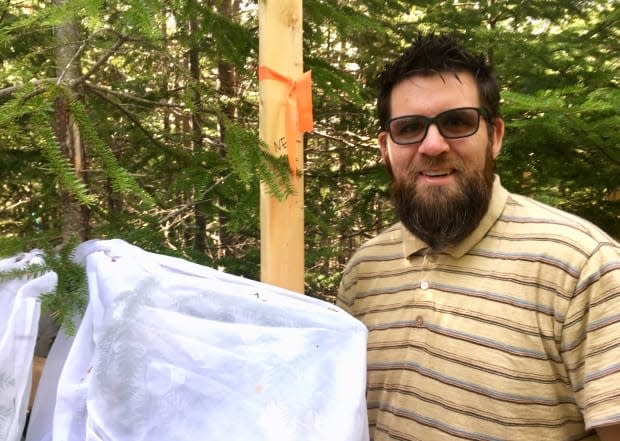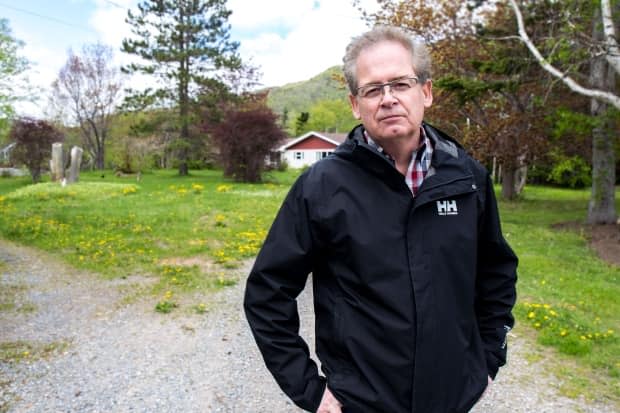As spruce budworm numbers rise, so does the battle against them — except in Gros Morne

A spraying program is quadrupling to battle rising spruce budworm numbers in western Newfoundland, but Parks Canada has decided to opt out of the effort and let nature take its course within Gros Morne National Park.
About 140,000 hectares of forest, from the Port au Port Peninsula northwards to Castor's River on the Northern Peninsula will be sprayed from the sky with biological insecticide BTK beginning in mid-June.
That's almost four times the area the provincial government sprayed last year when it began an early intervention spraying program against the insect, whose ravenous appetite for spruce and fir can ravage forests — a major outbreak in Newfoundland in the 1970s affected 90 per cent of the island's trees.
Scientists aren't calling the current circumstances an outbreak just yet, but the numbers of budworm in the trees is increasing — fuelled by moths that lay budworm eggs carried over on air currents from an outbreak in Quebec.
"A few years ago, there was barely an insect on a tree that we could find in the research that we were doing," said Eric Moise, a research scientist and entomologist with the Canadian Forest Service, based in Corner Brook.
Moise said researchers are now seeing branches with 30 to 40 spruce budworms eating away at them. It's too early to peg bug numbers at this point — populations are counted in the fall — but the trend, and warnings, are clear.
"Just looking at sort of the contemporary data that we're collecting now, we certainly have no reason to believe that it would be a light outbreak … we would be surprised if there wasn't a good amount of tree mortality in the coming years, if not for the [spraying] program," said Moise.

Gros Morne a no-go
But that early intervention program won't be going ahead in Gros Morne, an area estimated to hold about 10 per cent of the current budworm population of concern, according to Parks Canada's Roger Steadman.
The provincial government asked to include the national park in its spraying program for 2021, but after a public consultation process the park chose not to. BTK is a naturally occurring bacteria, approved for use in organic farming, that kills caterpillars like the budworm when they eat it and doesn't affect other species of animals, plants or humans.
But that's too much of an intervention for the park's liking.
"When we look at the spruce budworm outbreak from a Parks Canada perspective, it's a natural process," said Steadman, a project manager with the western Newfoundland and Labrador field unit.
"It's really critical to the forest being healthy and renewing itself. So for a national park, that natural process really needs to be allowed to continue unless there's an overwhelming reason not to."
No spraying virtually guarantees spruce budworm will kill off trees, and Steadman said Parks Canada will be preparing to make sure visitors understand why parts of the park are dying in the coming years.
The provincial government's Department of Fisheries, Forestry and Agriculture declined an interview, but said in a statement it plans to conduct insect count surveys this fall "to determine the effectiveness of this year's program," including in spots around the park.

Forestry industry 'disappointed'
The feedback Parks Canada received "varied greatly," said Steadman. Environmental groups weighed in against it, with similar feedback from the general public and Indigenous groups.
Forestry groups sided with spraying, citing economic concerns for timber, and were unhappy with the final decision, saying Parks Canada was shirking its responsibility.
"We're disappointed. Greatly disappointed," said Bill Dawson, executive director of the Newfoundland and Labrador Forestry Industry Association. He says he's worried an outbreak will hurt local sawmills and other forestry companies that export goods, contributing tax revenue to the provincial economy.
Dawson said the province will have to spray more heavily in the areas surrounding the park to compensate, and he feels that Parks Canada did a poor job explaining BTK's relatively benign effects compared with other insecticides.
"We believe when they did the communications, it lacked the education on what BTK is. How it's a natural bacteria and how it's used in the spray program," he said. But I think if people understood that, they … wouldn't be so adverse to it."

Spraying success
While Gros Morne will stay BTK-free, scientists will also continue to use the area to research spruce budworm, with the park acting as a control site for the sprayed forest around it.
"We'll be able to look at comparable sites within the park and then ask a series of questions about sort of the management versus no management scenario, and what that means for budworm dynamics, as well as various other aspects of forest ecology," said Moise.
Early spraying for spruce budworm has proven to be a success elsewhere, in terms of saving forests for their economic value. New Brunswick adopted the strategy in 2014 to protect itself from the Quebec infestation, a move that has been credited with protecting timber and keeping forests intact.
"By all accounts, it's been very effective in that jurisdiction," said Moise.
Scientists like Moise are working to better understand natural predators of spruce budworm in Newfoundland, such as certain wasps, in the hopes that those predators, instead of spraying, will be able to do the work in the future.
"It will certainly help us in the context of the early intervention strategy, because ultimately the goal is not to eradicate one worm, but to bring them down to a level where natural enemies can take back control of those populations."

